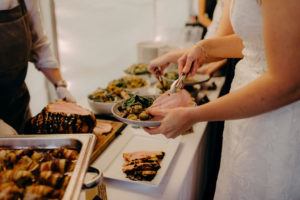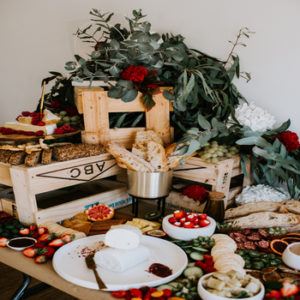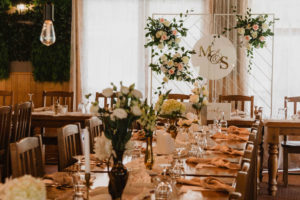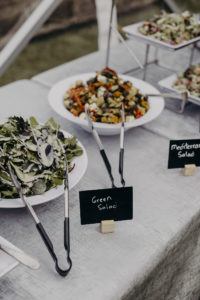
Undoubtedly when planning your wedding deciding what food to have and how it will be served is a biggy.
With so many options these days I will break down some pro and cons of each so you can decide what way to go.
The Plated Meal
A plated meal usually consists of three courses, being an entree, main and dessert. Generally, you’ll choose between two to three different options for each course. A sit-down plated meal is definitely the most formal option.
Pros of the plated meal
- This option gives the best flow to the night, you can set the times for each course and stick to a firm time frame.
- Everyone is served at the same time, so you can guarantee all guests will be fed and comfortable
- Your caterer will then be able to give you a cost per person for your menu, so you can easily see how much of the budget you’ll need to set aside according to your guest numbers.
- Because the portion sizes have been allocated for each guest, this option also means no wastage. When it comes to being economical, a plated meal definitely offers you these benefits.
- Styling table-wise it gives you so many options you know how much space you are working with.
Cons of the plated meal
- It restricts people to the spot they are in, they don’t tend to get up and move and often stay at their own table for the duration of the dinner.
- You may need to pay more for additional inserts for your RSVPs to confirm guest meals.
- Because your guests are being served their dinner, It does mean more wait staff required throughout the night increasing this portion of the budget.
The Plated Meal: Alternate Drop
Alternate drop menus include two dishes served alternatively around the table. Guests don’t actually order their choice of dish, but the idea is that they are free to swap with their neighbour if they wish.
Pros of the alternate drop.
- A lot like the basic plated meal timing is consistent and everyone is served at the same time.
Cons of the Alternate drop.
- With so many dietary restrictions these days, the alternate drop also presents a logistical nightmare when it comes to getting the right meal (gluten-free, vegan, halal, kosher, nut-free, seafood-free, etc) to the right person.
The Family Style Menu
A family style menu refers to shared platters of food that are placed down the middle of the table, along with serving utensils for each dish. It basically replicates a family dinner at home but on a much larger scale!
Pros of the family style menu
- A family style menu is a far more casual and relaxed alternative to the more formal plated meal. This also requires less staff so this will keep costs down.
- This menu service style also naturally encourages conversation between guests. It can be a great way to get people mingling throughout dinner and breaking the ice!
- There is no need for your guest to pre-order which make the RSVPs easier.
- A family style menu also means more variety for your guests to enjoy. Instead of a choice between two courses, there will be a selection of options for them to pick and choose from.
Cons of the family style menu
- One of the downsides of a family style menu is that there isn’t any form of portion control! You can’t really assume how much each guest is going to eat, so it can be trickier for your caterer to assume a price per person.
- Or your guests might eat much less than expected and leave you with piles of uneaten food. It’s not quite as economical as some other menu styles due to the potential wastage.
- Another consideration is the mess. With guests serving themselves and passing platters amongst each other, don’t expect your tables to remain in pristine condition!
- Larger plates for the food often take up a lot of table space, you will need to consider this in your table setting and styling.
- Larger serving plates often come with an additional hire charge, ask your caterer.
The Buffet
A long buffet table filled with food is set up in walking distance from your guest tables.
Guests will fill up their plates to take back to the table, going back and forth as often as they like. You might just have a buffet for the main course, or it could also include your entree and dessert options too. This tends to be the most common option for New Zealand weddings.
Pros of the buffet
- A buffet generally offers even more variety than a family style menu. It’s a great way for guests to try a little bit of everything, and perfect for picky eaters.
- Self-service at a buffet can be an easier option than having guests passing platters around the table.
- Probably the cheapest option on a per person basis.
Cons of the buffet
- Buffets often take a while to get through everyone so be aware of this when putting together your timetable.
- You also have zero portion control due to the nature of self-service.
- It’s definitely not the best option for tight spaces so make sure you figure out your table layout before choosing this style of food service.

Cocktail style or Grazing Table
If you’re planning cocktail style / stand up reception or grazing table, it goes without saying that your service options are going to be a little different to a sit-down affair.
Food service is usually in the form of wait staff roaming around with canapes, or a designated food station like a grazing table. Guests won’t be seated so the food either needs to come to them or be easily accessible.
Pros of cocktail style
- A cocktail style menu means that your guests have the option to try a selection of different foods without the flow of the night being interrupted.
- Your guests won’t have to spend hours waiting for others to finish their meals before the next course is served, or line up in a queue to get fed!
- The possibilities are endless when it comes to cocktail style service, so you can totally personalise it according to what reflects you best as a couple and your vision for the day.
- This options takes up little space and has a huge visual impact!
Cons of cocktail style
- Serving sizes are generally smaller for cocktail style food so there can be some concern with making sure everyone has enough to eat. For weddings where there is alcohol, it’s even more important to make sure everyone is well-fed.
- If you’ve opted for roaming canapes rather than a communal grazing table, then there is also a possibility that some guests might find themselves in the wrong place at the wrong time and continue to miss out on the servers.
- It can also be a little trickier for those guests who may have dietary requirements. Not only will you have to make sure there is a separate option to cater for their needs, but you’ll need to make sure whatever you have organised finds it’s way to them during the night.
- These options change the flow of the evening. You will need to rely on your MC a lot to get the attention of the guest for things like speeches, cake cutting and the first dance.
Food trucks
These beauties have well and truly taken over the wedding world recently and for good reason!
Pros of the food truck.
- Food trucks are bang on-trend. With so many trucks out there, the options are endless.
- Having a food truck area is also a brilliant way to get guests roving and mingling.
- Easy clean up if you are using disposable plates and cutlery.
Cons of the food truck
- Space is a big deal for food trucks, so you’ll have to be upfront with your reception venue and see if they’ll be accommodating.
- Anytime food would be served outdoors, the weather is a major factor. Waiting in line for food in the rain isn’t exactly a wonderful start to a reception.
- Be aware of any travel costs, permits and council regulations.
- Talk to the caterer regarding how many meals they can make or hold at any one time. One truck may not be enough for a large wedding.



Leave a Reply